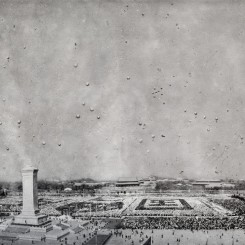Ground Control to Major Zhang
His fame continued to grow, his prices continued to rise, and in the crammed but rapidly expanding universe of China’s blogosphere, Zhang attracted criticism that, deserved or not, reflective or jealous, focused on personality rather than art. Yet in recent years he has had a series of striking installation exhibitions in China and his ash paintings have become a substantial body of work in their own right. Rather than seeing these practices in isolation it is time to gauge Zhang Huan’s recent practice as a whole.
The Mountain is Still a Mountain
This summer Zhang Huan had two major exhibitions of his wall-based works. The first was at the Art Gallery of Ontario and focused on Zhang’s ash paintings and “memory doors.” The second at White Cube gallery in London focused on a series of twenty recent ash works, The Mountain is Still a Mountain. Composed of the sifted ash from incense sticks burnt at Buddhist temples in Shanghai, the ash is laboriously sorted according to the precise shades of grey or black, size and texture, and then meticulously affixed to a surface, such as linen. They recall the colored sand mandala floor-paintings of Tibetan monks, and the revenant prayers of ordinary people living in China’s biggest metropolis — parents, students, office workers, teachers, cooks, policeman, migrant workers…politicians? In a short video prepared by the Art Gallery of Ontario, Zhang describes the role of ash:
When I returned to China from New York, in the temple I saw those good men and good women who burn incense to Buddha, and I began to wonder what kind of magic it was that affects us Chinese. People go there with hope to change their situation, to realize their dreams. Finally, when I saw the burning ashes in the incense burner, I suddenly had an epiphany, I realized that the burning ashes are not what they seem to be, they are our soul, our spirit, they are the memory and desire of a country. Everything we are, everything we believe and want are within these ashes.
Interview with Zhang Huan on the Art Gallery of Ontario show, 2012, Art Gallery of Ontario.
Hopes, desires, fears, emotional DNA, are atomized and recycled to form images of memory, popular and personal, but all historic in scale. People, unknown, ordinary — representatives of millions — stand equal with the great works and personalities, heroes and villains both (absent Mao), of China’s revolutionary and post-revolutionary history.
They are described as paintings, the art of affixing pigment to a surface. Yet this does not adequately reflect the mode of production. Composited by hundreds of hands, these are not simply paintings but epic acts of patience and diligence, blowing up images that might have been no larger than a hand or a large postage stamp to heroic proportions. Their production is a performance of memory. (Also a conceit: the artist in Zhang Huan plays on our addiction to mimetic nostalgia — the sepia sigh, while the showman in him plays on our lachrymose weakness for hug-an-urn cliché).
Although the ash paintings date from 2007, it was in 2008 that Zhang effectively announced his new technique with the installation “Canal Building,” a great slice of layered ash (180 x 1800 x 600 cm), the image on top only properly viewable from a raised platform. Potentially there are many images, the others hidden, Troy-like, below umpteen sedimentary layers. From the beginning then Zhang’s ash paintings were about the archaeology of history and memory. Are they meant to console or indict? It depends on what you find in them – this being an ambivalent platitude, an intellectually relativist fog, or a strategy for saying the otherwise unspeakable, under the hazy cover of the other (party). But this too is reductivist. Ambiguity, after all, should be the seed of responsibility, even culpability, in that one must seek out truth, decide for oneself. To re-member.
Scores of these now seemingly ubiquitous works have been produced since 2007. Frequently returning to the same themes, reincarnations of public and private portraits and propagandistic grands projets, but these are not simple generic scenes; there are patterns in the weave. Before Zhang Huan moved to the Central Academy of Art (CAFA) in Beijing aged 26, he taught Western art history at Zhengzhou College of Education, Henan Province. He lived for eight years in New York and still travels widely. He is acutely aware of the history of images, whether Chinese or Western.



